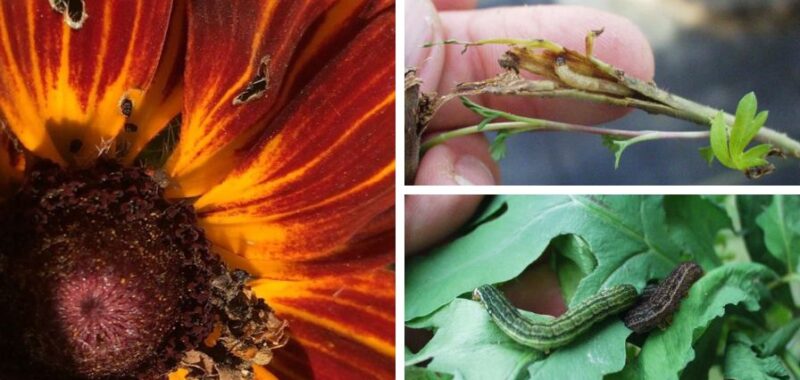
(Clockwise from left) Camouflaged looper and damage to rudbeckia, bidens borer caterpillar in stem, and Florida fern caterpillars. | Daniel Gilrein, Cornell Cooperative Extension of Suffolk County
In a recent e-Gro Alert, Dan Gilrein, an Entomology Specialist at the Cornell Cooperative Extension of Suffolk County, covered a range of crops that are unintentionally attractors to certain unique and uncommon pests, rather than just pollinators. Here’s a look at some of the uncommon pests that greenhouse growers might encounter, and what types of flowers they’re most often found feeding on.
Yellow-Striped Armyworm (Spodoptera ornithogalli)
The yellow-striped armyworm usually arrives “during the onset of cool fall weather,” and can remain into spring. Gilrein has observed them on “cyclamen, zonal geraniums, begonias, and other annuals” in addition to vegetable transplants.
“The older stages are mostly dark with two thin bright-yellow sometimes broken lines along the back and notorious for resistance or tolerance to some insecticides.”
European Pepper Moth (Duponchelia fovealis)

European pepper moth caterpillar. | Daniel Gilrein, Cornell Cooperative Extension of Suffolk County
Once thought to be a serious risk for widespread spread and infestation, the European pepper moth (EPM) potential was overestimated, but it still pops up from time to time to plague operations. Gilrein notes that although there is a large list of host plants, as noted by the University of Florida Institute of Food and Agricultural Sciences, he has mostly observed them chewing on the stems and foliage of chrysanthemums.
“It pupates in silk cocoons covered with soil or media and frass attached to the plant, the pot, or soil surface. The small (to 30mm/1.25″) whitish to light brown caterpillars, with small dark spots, may vary in color according to the host plant.”
Celery Leaftier (Udea rubigalis)
The celery of greenhouse leaftier also has a long list of host plants, but is most commonly found on chrysanthemums and lettuce, feeding on the lower leaves.
“Though damage can be mistaken for that caused by EPM, this one pupates in a loose web with leaves often in the lower plant canopy.”
Florida Fern Caterpillar (Callopistria floridensis)
The Florida fern caterpillar often appears in several colors, “varying from light green to black,” with hosts including “Boston and other sword ferns, maidenhair, silver, and several other ferns.” When young, these caterpillars are often able to feed on the host plant undetected due to their inconsistent coloring and damage hidden by leaves.
Fern Moth (Herpetogramma theseusalis)

Fern moth shelter. | Daniel Gilrein, Cornell Cooperative Extension of Suffolk County
Native to the Eastern U.S., the fern moth is most recognized for its unique home construction on host plants, which involves “balling up terminals on fern fronds where they can feed protected within.” These caterpillars often “overwinter around the base of plants and resume feeding on leaves in spring when the structures are formed.” While plants usually still survive, the leftover “home” and feeding damage from his pest are usually very noticeable, leaving growers with an often unsellable product.
“Ostrich fern has been most affected, though marsh and sensitive ferns are also reported hosts.”
Bidens Borer (Epiblema otiosana)
By boring into stems, the bidens borer often causes shoot dieback in affected crops and was initially mistaken by Gilrein as the European corn borer (ECB). In addition to greenhouse-grown and wild bidens, other reported hosts include ragweed and smartweed.
Camouflaged Looper (Synchlora aerata)
Gilrein notes that the camouflaged looper gets its name from its tactic of “decorating itself with bits of the flowers it feeds upon, enabling them to hide in plain sight from potential enemies.” Sometimes observed in cut flower production, its favorite hosts are flowers within the daisy family.
“The adult, called the wavy-lined emerald, is a beautiful pale green moth. A few other related species in the southern U.S. share the same sartorial habits.”
For information on additional uncommon floriculture pests, what plants attract them, and photo evidence of their presence on greenhouse crops, please read the full e-Gro (Electronic Grower Resources Online) alert “Eats Shoots and Leaves.” Additional and current e-Gro alert pieces from Volume 14 (2025) can be found online.

